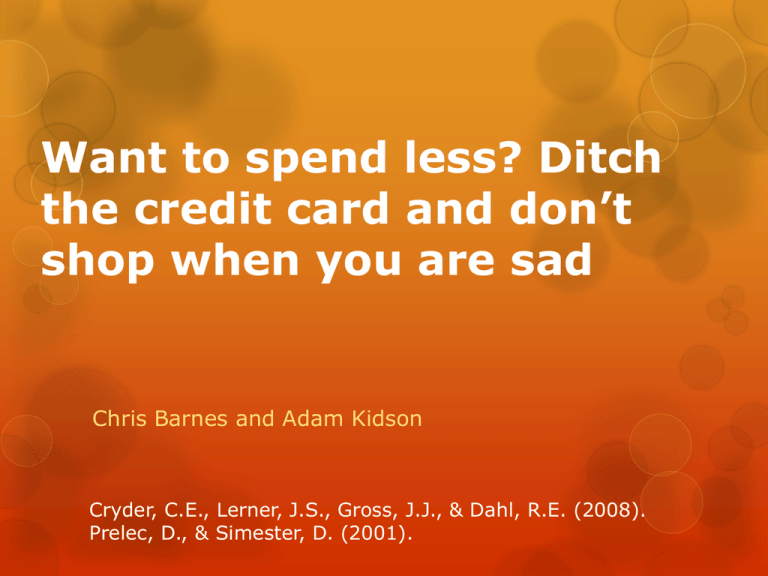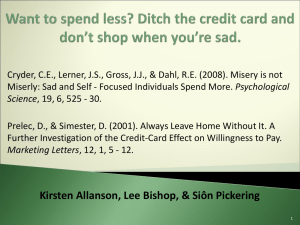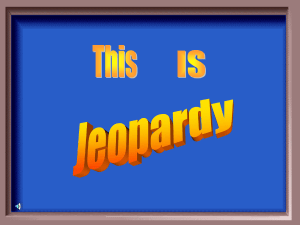
Want to spend less? Ditch
the credit card and don’t
shop when you are sad
Chris Barnes and Adam Kidson
Cryder, C.E., Lerner, J.S., Gross, J.J., & Dahl, R.E. (2008).
Prelec, D., & Simester, D. (2001).
Contents
Introduction
Research paper 1 - Misery is not Miserly…
Research paper 2 - Always Leave Home Without It…
Linking the research papers to the Begley article
Conclusion
Introduction – Inside the shopping brain
2008 recession – Begley article looking at
psychology behind consumer spending.
Referenced 2 articles
―Cryder et al. (2008)
―Prelec & Simester (2000)
Misery is not Miserly - Rational
This article looks for empirical connections between
the self and emotion in context of the misery is not
miserly effect.
Effects of sadness on buying run counter to
predictions
Sadness Increase in valuation of commodities.
Model of how sadness and self-focus
influence valuation of material possession
Misery is not Miserly – Hypothesis,
Prediction and Goals
Hypothesis
―That the experience of feeling sad and self focused
leads individuals to pay more for commodities than
the other wise would.
Prediction
―When self-focus is high, sad individuals experience an
implicit devaluation of the self, which in turn triggers
increased valuation of new commodities.
Primary Goal – Test two implications of model.
― Whether misery is not miserly effect depends on one’s level
of self focus.
― Whether self-focus explains the misery is not miserly
effect.
Misery is not Miserly - Methods
3 Tasks
―Emotion induction
Sad – video on death of boys mentor (from the Champ)
Neutral – video on Great Barrier Reef
―Self focused essay
Sad – how situation like one in video would affect them
Neutral – Daily activities
―Buying task
Buy water bottle
Manipulation check and Debriefing
Misery is not Miserly - Results
Does self-focus moderate the misery not
miserly effect ?
Does self focus mediate the misery not miserly
effect?
Misery is not Miserly – Results Summary
Misery is not miserly effect occurs only
when self-focus is high.
Self focus moderates effect of sadness on
spending.
High levels of self-focus mediate
relationship between sadness and
spending.
Sadness and self focus influence buying
prices.
Misery is not Miserly - Alternative
Explanations and Implications
Mood Repair theories although appearing to work
don’t mention self focus.
Could be - sad and self-focused individuals
reduced self value, therefore value other things
more.
Valence based models of affect and decision making
need updating.
Depression Increased self-focus and diminished
sense of worth.
Credit Card effect - Rational
Evidence supporting conjecture that credit cards
increase spending
Several previous tests in this area
Credit card premium
The effect can be large – up to 200%
Mainly indirect testing
Credit Card effect – Hypothesis and Prediction
People are willing to spend more when using a
credit card over cash
Two separate studies using real money
transactions
Use payment type and credit card logo exposure to
see what affects the most
Knowledge of the market price tested also
Credit Card effect – Methods – Study 1
Prizes – Willingness to pay for tickets to sporting
events
Three prizes up for second-price sealed-bid auction
for MBA students
Student randomly allocated payment condition
sheets.
Payments to be made by the next day
Credit Card effect – Results – Study 1
Credit Card effect – Methods – Study 2
Testing where market value is known – Gift
certificates for a local restaurant
Used Becker-DeGroot procedure to gain reservation
values
Students split into four groups
Credit Card effect – Results – Study 2
Credit card premiums
of -13% and 36%
Students providing
card details show
similar figures to
study 1
Students not providing
details show little
differentiation of
payment method vs
price
Credit Card effect - Conclusions
Study 1 shows the presence of the credit card
effect
Credit card effect greater when market value
unknown
No evidence that exposure to logos increased
willingness to pay
Willingness-to-pay varies depending on payment
method
Begley article – How they link
Sadness and Spending + Cash vs Credit
Begley – spending cash activates insular giving
you negative feelings
Study 1 – people spend more when sad
Study 2 – people spend more on credit cards
Spending cash can give negative emotions
Spending on credit cards numbs consumers from
the pain of parting with money
Begley article – How they link
Therefore sad people with credit cards may be a
poor combination
The pain of spending on cards hits home when
numbness wears off
Much worse than the initial hit if spending cash –
with interest
Insular prevents people from getting into trouble
Credit card = Anti-insular device?
Relevance – Further Research
Quite a high level of relevance to each other and
seems to fit with the real world and our own
experiences
Further research:
―Give sad people a credit card and vice versa
―Observational study on the spending habits of
people with Bipolar disorder
―Does experience matter?
―Does Sex matter?
Take home message
Avoid shopping when sad
If you have to shop when sad, leave the credit
card at home
If possible, don’t use credit cards at all
References
Ausubel, Lawrence M. (1991). “The Failure of Competition in the Credit Card
Market,'' American Economic Review 81, 50-81.
Becker, Gary M., Morris H. DeGroot, and Marschak, Jacob. (1964). “Measuring
Utility by a Single-response Sequential Method,'' Behavioral Science 9, 226232.
Blumberg, S.R., & Hokanson, J.E. (1983). The effects of another person’s
response style on interpersonal behavior in depression. Journal of Abnormal
Psychology, 192, 196–209.
Clark, M.S., & Isen, A.M. (1982). Towards understanding the relationship
between feeling states and social behavior. In A.H. Hastorf & A.M. Isen (Eds.),
Cognitive social psychology (pp. 73–108). Amsterdam: Elsevier/North-Holland.
Cryder, C. E., J. S. Lerner, et al. (2008). "Misery is not miserly: Sad and selffocused individuals spend more." Psychological Science 19(6): 525-530.
Feinberg, Richard A. (1986). “Credit Cards as Spending Facilitating Stimuli: A
Conditioning Interpretation,'‘ Journal of Consumer Research 12, 384-356.
Gotlib, I.H., & Hammen, C.L. (1992). Psychological aspects of depression:
Toward a cognitive-interpersonal integration. New York: Wiley.
Hirschman, Elizabeth C. (1979). “Differences in Consumer Purchase Behavior
by Credit Card Payment System,'‘ Journal of Consumer Research 6, 58-66.
References
Ingram, R.E. (1990). Self-focused attention in clinical disorders: Review and a
conceptual model. Psychological Bulletin, 109, 156–176.
James, W. (1890). Principles of psychology. New York: Holt.
Lerner, J.S., Small, D.A., & Loewenstein, G. (2004). Heart strings and purse strings:
Carryover effects of emotions on economic decisions. Psychological Science, 15,
337–340.
Loewenstein, G., & Lerner, J.S. (2003). The role of affect in decision making. In R.
Davidson, H. Goldsmith, & K. Scherer (Eds.),
Prelec, D. and D. Simester (2001). "Always leave home without it: A further
investigation of the credit-card effect on willingness to pay." Marketing Letters 12(1):
5-12.
Soman, Dilip. (1999). Effects of Payment Mechanism on Spending Behavior: The
Illusion of Liquidity. Working Paper, Hong Kong University of Science and Technology,
Hong Kong.
Vickrey, William. (1961). “Counterspeculation, Auctions, and Competitive Sealed
Tenders,'' Journal of Finance 16, 8-37.
Watkins, E., & Teasdale, J.D. (2001). Rumination and overgeneral memory in
depression: Effects of self-focus and analytic thinking. Journal of Abnormal
Psychology, 110, 353–357.
Watkins, E., & Teasdale, J.D. (2004). Adaptive and maladaptive selffocus in
depression. Journal of Affective Disorders, 82, 1–8.
Any
Questions?








